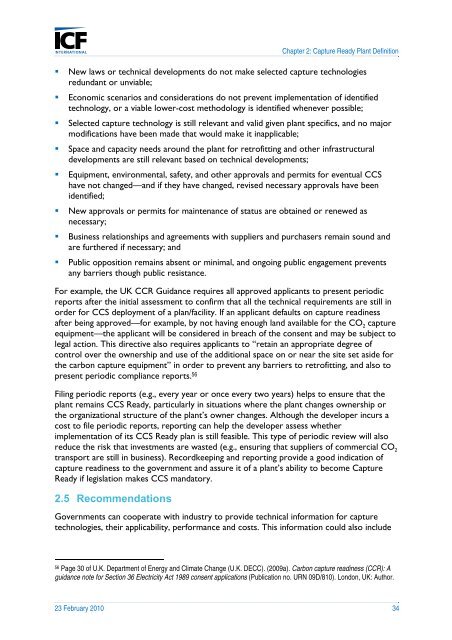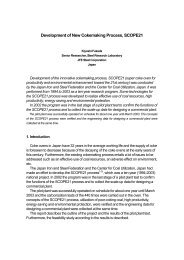Defining CCS Ready: An Approach to An International Definition
Defining CCS Ready: An Approach to An International Definition
Defining CCS Ready: An Approach to An International Definition
- No tags were found...
Create successful ePaper yourself
Turn your PDF publications into a flip-book with our unique Google optimized e-Paper software.
Chapter 2: Capture <strong>Ready</strong> Plant <strong>Definition</strong>• New laws or technical developments do not make selected capture technologiesredundant or unviable;• Economic scenarios and considerations do not prevent implementation of identifiedtechnology, or a viable lower-cost methodology is identified whenever possible;• Selected capture technology is still relevant and valid given plant specifics, and no majormodifications have been made that would make it inapplicable;• Space and capacity needs around the plant for retrofitting and other infrastructuraldevelopments are still relevant based on technical developments;• Equipment, environmental, safety, and other approvals and permits for eventual <strong>CCS</strong>have not changed—and if they have changed, revised necessary approvals have beenidentified;• New approvals or permits for maintenance of status are obtained or renewed asnecessary;• Business relationships and agreements with suppliers and purchasers remain sound andare furthered if necessary; and• Public opposition remains absent or minimal, and ongoing public engagement preventsany barriers though public resistance.For example, the UK CCR Guidance requires all approved applicants <strong>to</strong> present periodicreports after the initial assessment <strong>to</strong> confirm that all the technical requirements are still inorder for <strong>CCS</strong> deployment of a plan/facility. If an applicant defaults on capture readinessafter being approved—for example, by not having enough land available for the CO 2 captureequipment—the applicant will be considered in breach of the consent and may be subject <strong>to</strong>legal action. This directive also requires applicants <strong>to</strong> “retain an appropriate degree ofcontrol over the ownership and use of the additional space on or near the site set aside forthe carbon capture equipment” in order <strong>to</strong> prevent any barriers <strong>to</strong> retrofitting, and also <strong>to</strong>present periodic compliance reports. 56Filing periodic reports (e.g., every year or once every two years) helps <strong>to</strong> ensure that theplant remains <strong>CCS</strong> <strong>Ready</strong>, particularly in situations where the plant changes ownership orthe organizational structure of the plant’s owner changes. Although the developer incurs acost <strong>to</strong> file periodic reports, reporting can help the developer assess whetherimplementation of its <strong>CCS</strong> <strong>Ready</strong> plan is still feasible. This type of periodic review will alsoreduce the risk that investments are wasted (e.g., ensuring that suppliers of commercial CO 2transport are still in business). Recordkeeping and reporting provide a good indication ofcapture readiness <strong>to</strong> the government and assure it of a plant’s ability <strong>to</strong> become Capture<strong>Ready</strong> if legislation makes <strong>CCS</strong> manda<strong>to</strong>ry.2.5 RecommendationsGovernments can cooperate with industry <strong>to</strong> provide technical information for capturetechnologies, their applicability, performance and costs. This information could also include56 Page 30 of U.K. Department of Energy and Climate Change (U.K. DECC). (2009a). Carbon capture readiness (CCR): Aguidance note for Section 36 Electricity Act 1989 consent applications (Publication no. URN 09D/810). London, UK: Author.23 February 2010 34
















